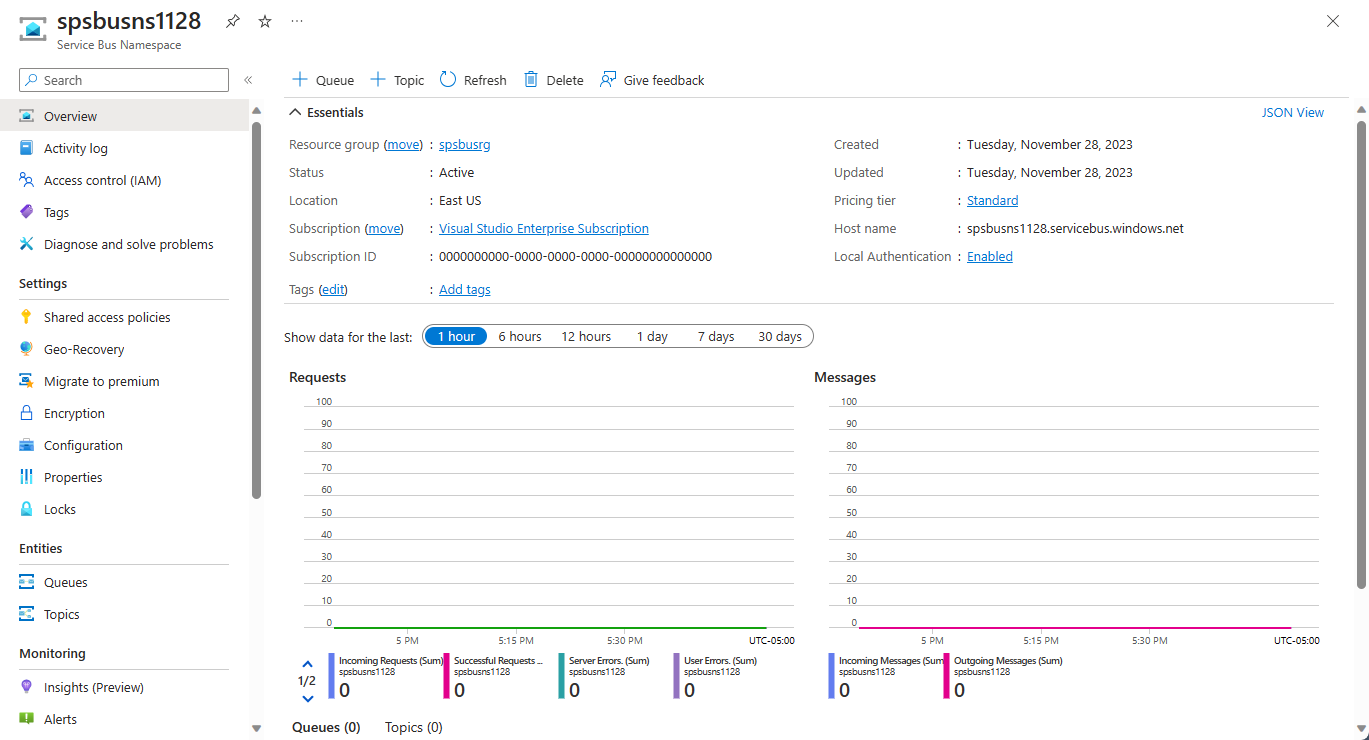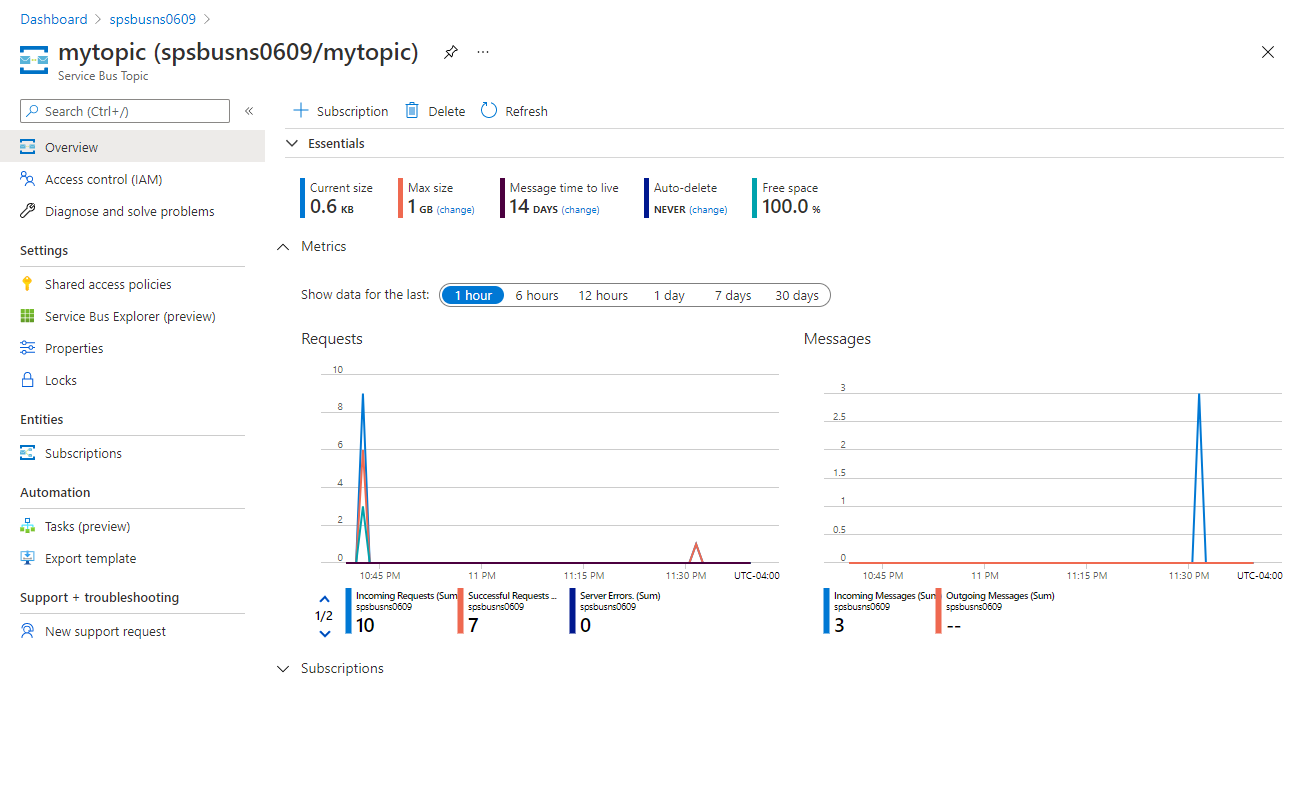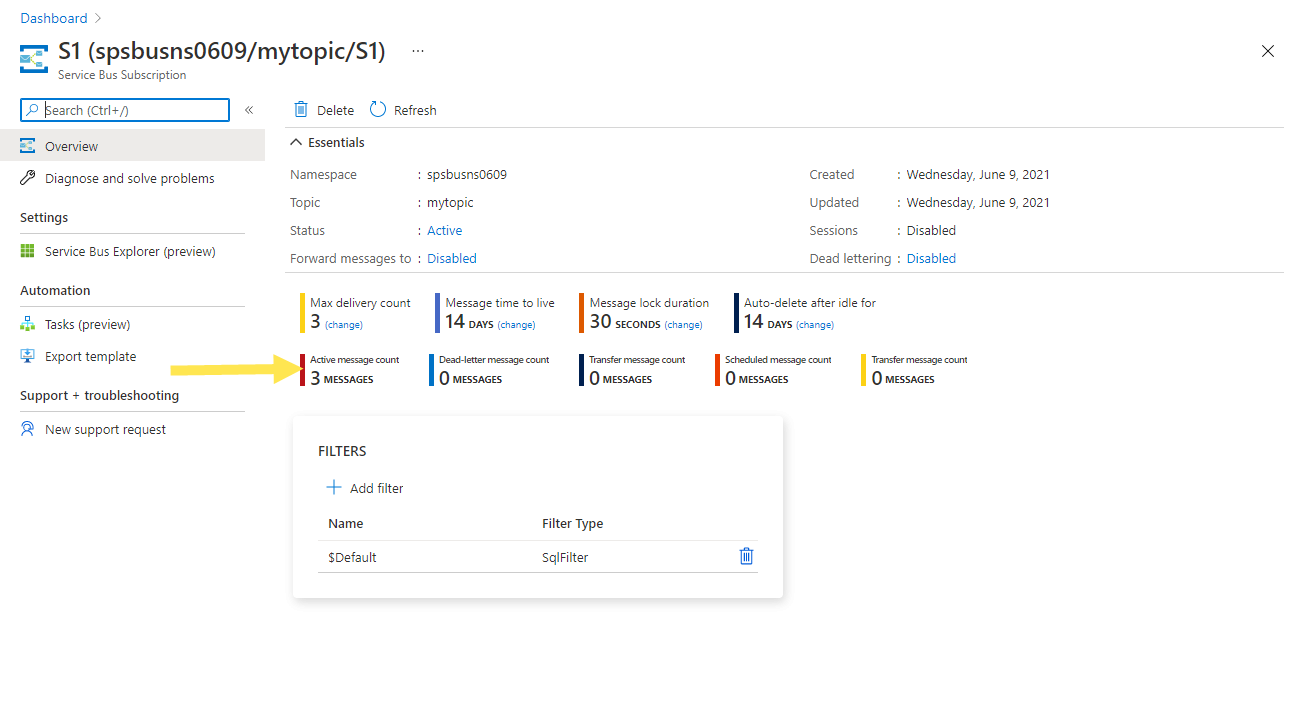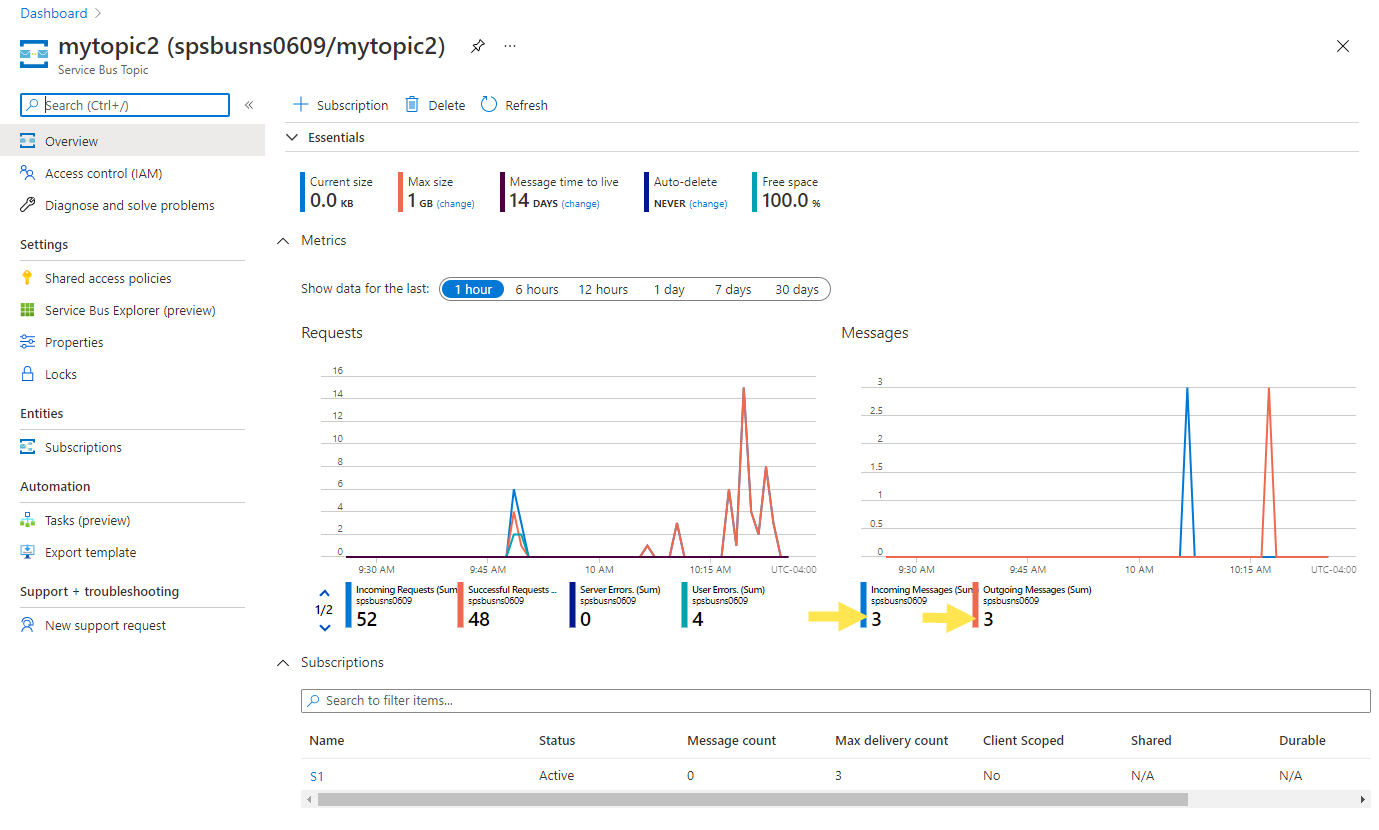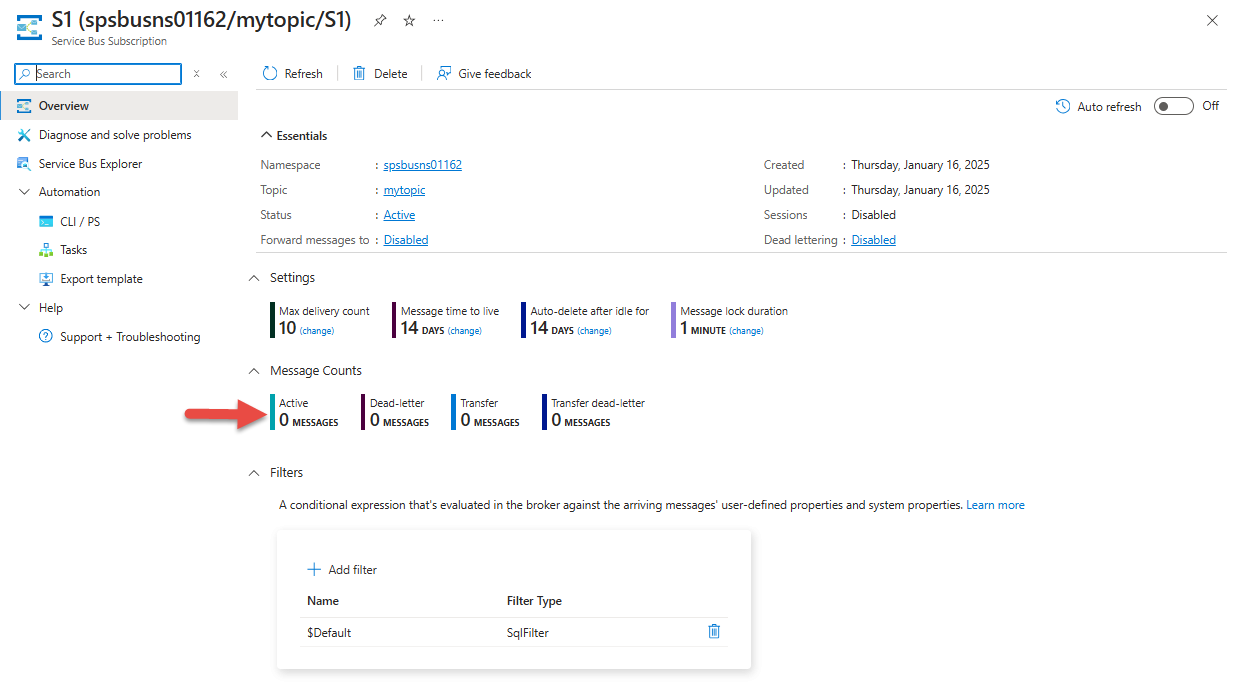快速入門:開始使用 Azure 服務匯流排 主題和訂用帳戶 (.NET)
本快速入門說明如何使用 Azure.Messaging.ServiceBus .NET 程式庫,將訊息傳送至服務匯流排主題,以及從該主題的訂用帳戶接收訊息。
在本快速入門中,您會執行下列步驟:
- 使用 Azure 入口網站建立服務匯流排命名空間。
- 使用 Azure 入口網站建立服務匯流排主題。
- 使用 Azure 入口網站,針對該主題建立服務匯流排訂用帳戶。
- 撰寫 .NET 主控台應用程式,以將一組訊息傳送到主題。
- 撰寫 .NET 主控台應用程式,以從訂用帳戶接收這些訊息。
注意
本快速入門提供逐步指示,以實作簡單的案例,將一批訊息傳送至 服務匯流排 主題,並從主題的訂用帳戶接收這些訊息。 如需其他和進階情節的更多樣本,請參閱 GitHub 上的服務匯流排 .NET 樣本。
- 本快速入門說明連線到 Azure 服務匯流排的兩種方式:連接字串 和無密碼。 第一個選項顯示如何使用連接字串來連線到服務匯流排命名空間。 第二個選項顯示如何使用 Microsoft Entra ID 中的安全性主體和角色型存取控制 (RBAC),來連線到服務匯流排命名空間。 您不需要擔心在程式碼或設定檔或 Azure Key Vault 等安全儲存體中,有硬式編碼連接字串。 如果您不熟悉 Azure,您可能會發現 連接字串 選項更容易遵循。 建議在真實世界應用程式和實際執行環境中使用無密碼選項。 如需詳細資訊,請參閱驗證與授權。
必要條件
如果您不熟悉服務,請先參閱服務匯流排概觀,再執行本快速入門。
- Azure 訂用帳戶。 若要使用 Azure 服務 (包括 Azure 服務匯流排),您需要訂用帳戶。 如果您沒有現有 Azure 帳戶,您可以註冊免費試用。
-
Visual Studio 2022。 範例應用程式會使用 C# 10 中引進的新功能。 您仍然可以搭配先前的 C# 語言版本使用服務匯流排用戶端程式庫,但語法可能會有所不同。 若要使用最新的語法,建議您安裝 .NET 6.0 或更高版本,並將語言版本設定為
latest。 如果您使用的是 Visual Studio,Visual Studio 2022 之前的版本與建置 C# 10 專案所需的工具不相容。
在 Azure 入口網站中建立命名空間
若要開始在 Azure 中使用服務匯流排傳訊實體,您必須先使用 Azure 中的唯一名稱建立命名空間。 命名空間為應用程式內的服務匯流排資源 (佇列、主題等) 提供範圍容器。
若要建立命名空間:
登入 Azure 入口網站。
瀏覽至 [所有服務] 頁面。
在左側導覽列上,從類別清單中選取 [整合],將滑鼠停留在 [服務匯流排] 上方,然後選取 [服務匯流排] 圖格上的 + 按鈕。
在 [建立命名空間] 頁面的 [基本] 標籤中,遵循下列步驟:
針對 [訂用帳戶],選擇要在其中建立命名空間的 Azure 訂用帳戶。
針對 [ 資源群組],選擇現有的資源群組,或建立新的資源群組。
輸入命名空間的名稱。 命名空間名稱應遵循下列命名慣例:
- 名稱在整個 Azure 中必須是唯一的。 系統會立即檢查此名稱是否可用。
- 名稱長度至少 6 個字元,最多 50 個字元。
- 名稱只能包含字母、數位、連字元
-。 - 名稱開頭必須為字母,且結尾必須為字母或數字。
- 名稱結尾不是
-sb或-mgmt。
針對 [位置],選擇應裝載命名空間的區域。
針對定價層,選取命名空間的定價層 (基本、標準或進階)。 針對本快速入門,選取 [標準]。
如果您選取 [進階層 ],請選取您是否可以啟用 命名空間的異地複 寫。 異地複寫功能可確保命名空間的中繼資料和資料會持續從主要區域複寫至一或多個次要區域。
重要
如果您想要使用主題和訂用帳戶,請選擇 [標準] 或 [進階]。 基本定價層不支援主題/訂用帳戶。
若已選取 [進階] 定價層,請指定傳訊單位數目。 進階層可讓您的資源在 CPU 和記憶體層級上獲得隔離,讓每個工作負載能夠獨立執行。 此資源容器稱為傳訊單位。 進階命名空間都至少有一個傳訊單位。 您可以為每個服務匯流排的進階命名空間選取 1、2、4、8 或 16 個傳訊單位。 如需詳細資訊,請參閱服務匯流排進階傳訊。
選取頁面底部的 [檢閱 + 建立] 。
![此圖顯示 [建立命名空間] 頁面](includes/media/service-bus-create-namespace-portal/create-namespace.png)
在 [檢閱 + 建立] 頁面上檢閱設定,然後選取 [建立]。
一旦部署資源成功,請在部署頁面上選取 [移至資源]。
![此圖顯示部署成功頁面及 [前往資源] 連結。](includes/media/service-bus-create-namespace-portal/deployment-alert.png)
您會看到服務匯流排命名空間的首頁。
使用 Azure 入口網站建立主題
在 [服務匯流排 命名空間] 頁面上,展開左側導覽功能表上的 [實體],然後選取左側功能表上的 [主題]。
選取工具列上的 [+ 主題]。
輸入主題的名稱。 保留其他選項的預設值。
選取 建立。
![顯示 Azure 入口網站 中 [建立主題] 頁面的螢幕快照。](includes/media/service-bus-create-topics-subscriptions-portal/create-topic.png)
針對主題建立訂用帳戶
選取您在上一節中建立的主題。
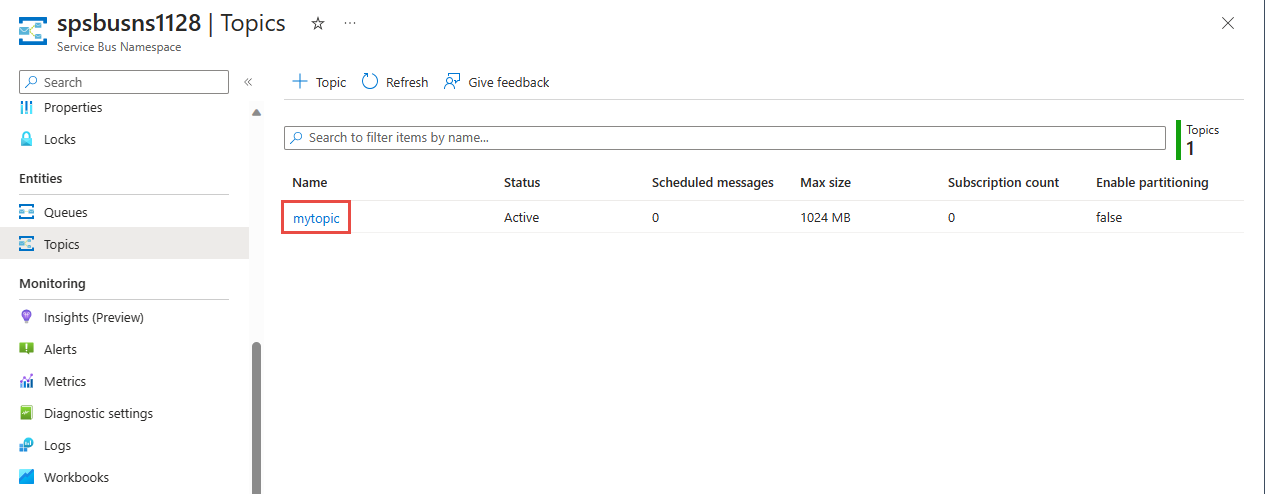
在 [服務匯流排主題] 頁面上,選取工具列上的 [+ 訂用帳戶]。
![顯示 [主題] 頁面上 [新增訂用帳戶] 按鈕的螢幕快照。](includes/media/service-bus-create-topics-subscriptions-portal/add-subscription-button.png)
在 [建立訂用帳戶] 頁面上,遵循下列步驟:
輸入 S1 作為訂用帳戶的 [名稱]。
然後,選取 [建立] 以建立訂用帳戶。
![顯示 [建立訂用帳戶] 頁面的螢幕快照。](includes/media/service-bus-create-topics-subscriptions-portal/create-subscription-page.png)
向 Azure 驗證應用程式
本快速入門顯示兩種連線到 Azure 服務匯流排的方式:無密碼和連接字串。
第一個選項顯示如何使用 Microsoft Entra ID 中的安全性主體和角色型存取控制 (RBAC),來連線到服務匯流排命名空間。 您不需要擔心在程式碼或設定檔或 Azure Key Vault 等安全儲存體中,有硬式編碼連接字串。
第二個選項顯示如何使用連接字串來連線到服務匯流排命名空間。 如果您不熟悉 Azure,則可能會發現連接字串選項更容易遵循。 建議在真實世界應用程式和實際執行環境中使用無密碼選項。 如需詳細資訊,請參閱驗證與授權。 您也可以在概觀頁面上,深入了解無密碼驗證。
將角色指派給 Microsoft Entra 使用者
在本機開發時,請確定連線到 Azure 服務匯流排的使用者帳戶具有正確的權限。 您需要 Azure 服務匯流排資料擁有者角色,才能傳送和接收訊息。 若要將此角色指派給您自己,您需要使用者存取管理員角色,或另一個包含 Microsoft.Authorization/roleAssignments/write 動作的角色。 您可以使用 Azure 入口網站、Azure CLI 或 Azure PowerShell,將 Azure RBAC 角色指派給使用者。 您可以在範圍概觀頁面上,深入了解角色指派的可用範圍。
下列範例會將 Azure Service Bus Data Owner 角色指派給您的使用者帳戶,該角色提供對 Azure 服務匯流排資源的完整存取權。 在實際案例中,遵循最低權限原則,只為使用者提供更安全實際執行環境所需的最低權限。
Azure 服務匯流排的 Azure 內建角色
對於 Azure 服務匯流排來說,透過 Azure 入口網站和 Azure 資源管理 API 來的管理命名空間和所有相關資源的作業,皆已使用 Azure RBAC 模型來加以保護。 Azure 提供下列 Azure 內建角色,以授權存取服務匯流排命名空間:
- Azure 服務匯流排資料擁有者:啟用對服務匯流排命名空間及其實體 (佇列、主題、訂用帳戶和篩選條件) 的資料存取。 此角色的成員可以從佇列或主題/訂用帳戶傳送和接收訊息。
- Azure 服務匯流排資料傳送者:使用此角色來授與服務匯流排命名空間及其實體的資料傳送權限。
- Azure 服務匯流排資料接收者:使用此角色來授與服務匯流排命名空間及其實體的資料接收權限。
如果您想要建立自訂角色,請參閱服務匯流排作業所需的權限。
將 Microsoft Entra 使用者新增至 Azure 服務匯流排擁有者角色
將您的 Microsoft Entra 使用者名稱新增至服務匯流排命名空間層級的 Azure 服務匯流排資料擁有者角色。 其可讓在使用者帳戶內容中執行的應用程式將訊息傳送至佇列或主題,以及從佇列或主題的訂用帳戶接收訊息。
重要
在大部分情況下,角色指派在 Azure 中傳播只需要一兩分鐘。 在少數情況下,可能需要長達八分鐘的時間。 如果您第一次執行程式碼時收到驗證錯誤,請稍候片刻再試一次。
如果沒有在 Azure 入口網站中開啟 [服務匯流排命名空間] 頁面,請使用主要搜尋列或左側導覽找出您的服務匯流排命名空間。
在概觀頁面上,從左側功能表中選取 [存取控制 (IAM)]。
在 [存取控制 (IAM)] 頁面上,選取 [角色指派] 索引標籤。
從頂端功能表選取 [+ 新增],然後從產生的下拉功能表中選取 [新增角色指派]。
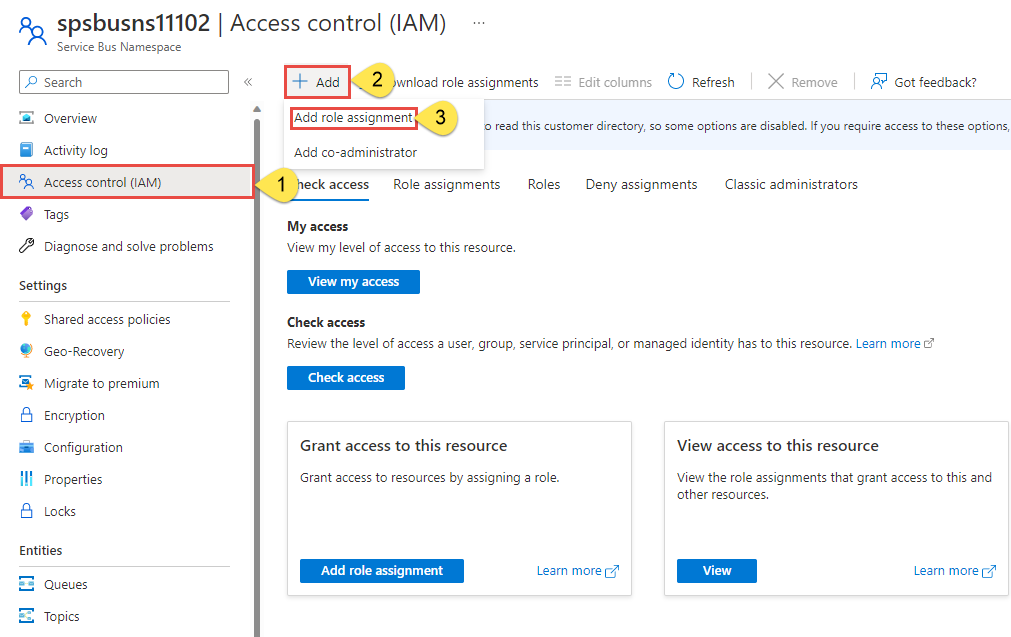
使用搜尋方塊,從結果篩選出所需的角色。 在此範例中,搜尋
Azure Service Bus Data Owner並選取相符的結果。 接著,選擇 [下一步]。在 [存取權指派對象為] 下,選取 [使用者、群組或服務主體],然後選擇 [+ 選取成員]。
在對話方塊中,搜尋 Microsoft Entra 使用者名稱 (通常是您的 user@domain 電子郵件地址),然後在對話方塊底部選擇 [選取]。
選取 [檢閱 + 指派] 以移至最終頁面,然後再次選取 [檢閱 + 指派] 以完成此程序。
啟動 Visual Studio
您可以使用下列步驟來授權存取服務匯流排命名空間:
啟動 Visual Studio。 如果您看到 [開始使用] 視窗,請選取右窗格中的 [繼續但不開啟程式碼] 連結。
選取 Visual Studio 右上方的 [登入] 按鈕。
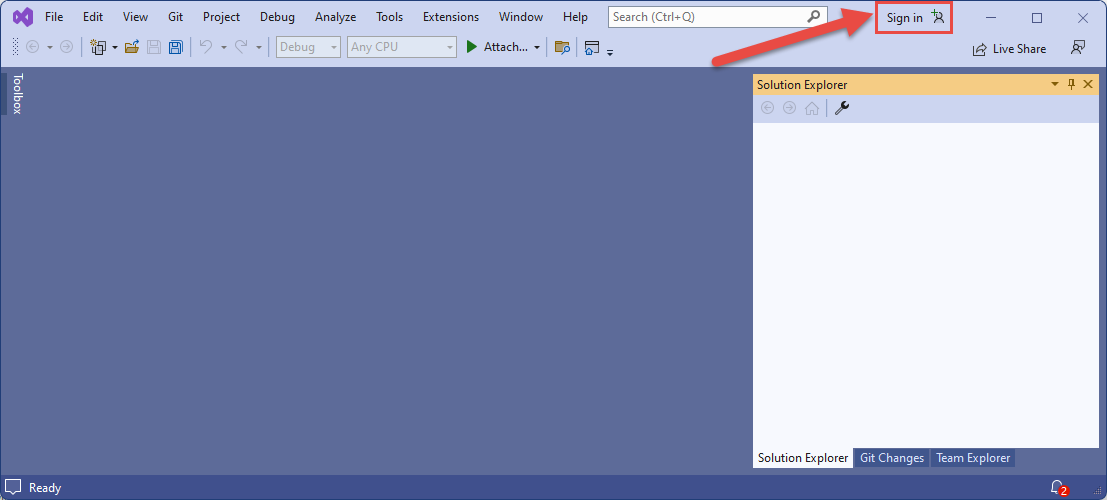
使用您先前指派角色的 Microsoft Entra 帳戶來登入。
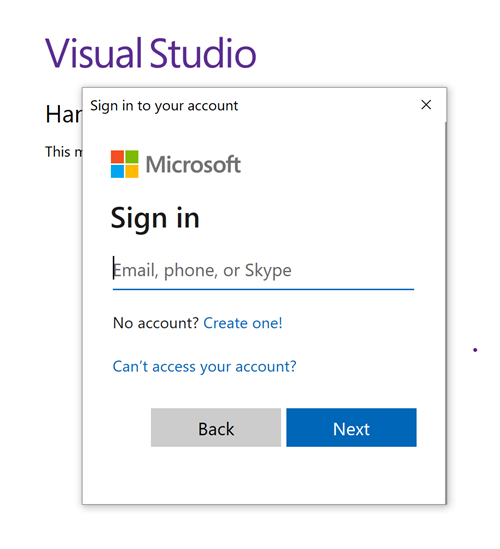
將訊息傳送到主題
本節說明如何建立 .NET 主控台應用程式,將訊息傳送至服務匯流排主題。
注意
本快速入門提供逐步指示,以實作簡單的案例,將一批訊息傳送至 服務匯流排 主題,以及從主題的訂用帳戶接收這些訊息。 如需其他和進階情節的更多樣本,請參閱 GitHub 上的服務匯流排 .NET 樣本。
建立主控台應用程式
- 在 Visual Studio 中,選取 [檔案] -> [新增] -> [專案] 功能表。
- 在 [建立新專案] 對話方塊上,執行下列步驟:如果您沒有看到此對話方塊,請在功能表上選取 [檔案]、選取 [新增],然後選取 [專案]。
選取 [C#] 作為程式設計語言。
選取 [主控台] 作為應用程式的類型。
從結果清單中選取 [主控台應用程式]。
然後選取下一步。
![此圖顯示 [建立新專案] 對話方塊,其中已選取 [C#] 和 [主控台]](media/service-bus-dotnet-get-started-with-queues/new-send-project.png)
- 在專案名稱中輸入 TopicSender、在解決方案名稱中輸入 ServiceBusTopicQuickStart,然後選取 [下一步]。
- 在 [其他資訊] 頁面上,選取 [建立] 以建立解決方案和專案。
將 NuGet 套件新增至專案
從功能表選取 [工具]>[NuGet 套件管理員]>[套件管理員主控台]。
執行下列命令來安裝 Azure.Messaging.ServiceBus NuGet 套件。
Install-Package Azure.Messaging.ServiceBus執行下列命令來安裝 Azure.Identity NuGet 套件。
Install-Package Azure.Identity
新增程式碼以將訊息傳送到主題
將 Program.cs 的內容取代為下列程式碼。 本節概述重要步驟,程式碼註解中有額外資訊。
- 使用
DefaultAzureCredential物件建立 ServiceBusClient 物件。DefaultAzureCredential會自動探索並使用 Visual Studio 登入的認證,向 Azure 服務匯流排進行驗證。 - 在
ServiceBusClient物件上叫用 CreateSender 方法,以針對特定服務匯流排主題建立 ServiceBusSender 物件。 - 使用 ServiceBusSender.CreateMessageBatchAsync 建立 ServiceBusMessageBatch 物件。
- 使用 ServiceBusMessageBatch.TryAddMessage 將訊息新增至批次。
- 使用 ServiceBusSender.SendMessagesAsync 方法,將訊息批次傳送至服務匯流排主題。
重要
使用服務匯流排命名空間和主題的名稱,更新程式碼片段中的預留位置值 (
<NAMESPACE-NAME>和<TOPIC-NAME>)。using System.Threading.Tasks; using Azure.Messaging.ServiceBus; using Azure.Identity; // the client that owns the connection and can be used to create senders and receivers ServiceBusClient client; // the sender used to publish messages to the topic ServiceBusSender sender; // number of messages to be sent to the topic const int numOfMessages = 3; // The Service Bus client types are safe to cache and use as a singleton for the lifetime // of the application, which is best practice when messages are being published or read // regularly. //TODO: Replace the "<NAMESPACE-NAME>" and "<TOPIC-NAME>" placeholders. client = new ServiceBusClient( "<NAMESPACE-NAME>.servicebus.windows.net", new DefaultAzureCredential()); sender = client.CreateSender("<TOPIC-NAME>"); // create a batch using ServiceBusMessageBatch messageBatch = await sender.CreateMessageBatchAsync(); for (int i = 1; i <= numOfMessages; i++) { // try adding a message to the batch if (!messageBatch.TryAddMessage(new ServiceBusMessage($"Message {i}"))) { // if it is too large for the batch throw new Exception($"The message {i} is too large to fit in the batch."); } } try { // Use the producer client to send the batch of messages to the Service Bus topic await sender.SendMessagesAsync(messageBatch); Console.WriteLine($"A batch of {numOfMessages} messages has been published to the topic."); } finally { // Calling DisposeAsync on client types is required to ensure that network // resources and other unmanaged objects are properly cleaned up. await sender.DisposeAsync(); await client.DisposeAsync(); } Console.WriteLine("Press any key to end the application"); Console.ReadKey();- 使用
建置專案,並確定沒有任何錯誤。
執行程式,並等待確認訊息。
A batch of 3 messages has been published to the topic重要
在大部分情況下,角色指派在 Azure 中傳播需要一兩分鐘的時間。 在罕見的情況下,可能需要高達八分鐘的時間。 如果您第一次執行程式碼時收到驗證錯誤,請稍候片刻再試一次。
在 Azure 入口網站中遵循下列步驟:
自訂用帳戶接收訊息
在本節中,您會建立一個 .NET 主控台應用程式,接收從訂用帳戶到服務匯流排主題的訊息。
注意
本快速入門提供逐步指示,以實作將一批訊息傳送至 服務匯流排 主題,以及從主題訂用帳戶接收這些訊息的簡單案例。 如需其他和進階情節的更多樣本,請參閱 GitHub 上的服務匯流排 .NET 樣本。
為接收者建立專案
- 在 [方案總管] 視窗中,以滑鼠右鍵按一下 [ServiceBusTopicQuickStart] 解決方案、指向 [新增],然後選取 [新增專案]。
- 選取 [主控台應用程式],然後選取 [下一步]。
- 輸入 SubscriptionReceiver 作為 [專案名稱],然後選取 [下一步]。
- 在 [其他資訊] 頁面上,選取 [建立]。
- 在 [方案總管] 視窗中,以滑鼠右鍵按一下 [SubscriptionReceiver],然後選取 [設定為啟動專案]。
將 NuGet 套件新增至專案
從功能表選取 [工具]>[NuGet 套件管理員]>[套件管理員主控台]。
針對 [預設專案] 下拉式清單選取 [SubscriptionReceiver]。
執行下列命令來安裝 Azure.Messaging.ServiceBus NuGet 套件。
Install-Package Azure.Messaging.ServiceBus執行下列命令來安裝 Azure.Identity NuGet 套件。
Install-Package Azure.Identity
新增程式碼以從訂用帳戶接收訊息
在本節中,您會新增程式碼以從訂用帳戶中擷取訊息。
將
Program.cs的現有內容取代為下列屬性和方法:using System.Threading.Tasks; using Azure.Messaging.ServiceBus; using Azure.Identity; // the client that owns the connection and can be used to create senders and receivers ServiceBusClient client; // the processor that reads and processes messages from the subscription ServiceBusProcessor processor; // handle received messages async Task MessageHandler(ProcessMessageEventArgs args) { string body = args.Message.Body.ToString(); Console.WriteLine($"Received: {body} from subscription."); // complete the message. messages is deleted from the subscription. await args.CompleteMessageAsync(args.Message); } // handle any errors when receiving messages Task ErrorHandler(ProcessErrorEventArgs args) { Console.WriteLine(args.Exception.ToString()); return Task.CompletedTask; }將下列程式碼附加至
Program.cs的尾端。- 使用
DefaultAzureCredential物件建立 ServiceBusClient 物件。DefaultAzureCredential會自動探索並使用 Visual Studio 登入的認證,向 Azure 服務匯流排進行驗證。 - 在
ServiceBusClient物件上叫用 CreateProcessor 方法,以針對特定服務匯流排主題建立 ServiceBusProcessor 物件。 - 針對
ServiceBusProcessor物件的 ProcessMessageAsync 和 ProcessErrorAsync 事件指定處理常式。 - 透過在
ServiceBusProcessor物件上叫用 StartProcessingAsync 來開始處理訊息。 - 當使用者按下按鍵結束處理時,會在
ServiceBusProcessor物件上叫用 StopProcessingAsync。
重要
使用服務匯流排命名空間、主題和訂用帳戶的名稱,更新程式碼片段中的預留位置值 (
<NAMESPACE-NAME>、<TOPIC-NAME>和<SUBSCRIPTION-NAME>)。如需詳細資訊,請參閱程式碼註解。
// The Service Bus client types are safe to cache and use as a singleton for the lifetime // of the application, which is best practice when messages are being published or read // regularly. // // Create the clients that we'll use for sending and processing messages. // TODO: Replace the <NAMESPACE-NAME> placeholder client = new ServiceBusClient( "<NAMESPACE-NAME>.servicebus.windows.net", new DefaultAzureCredential()); // create a processor that we can use to process the messages // TODO: Replace the <TOPIC-NAME> and <SUBSCRIPTION-NAME> placeholders processor = client.CreateProcessor("<TOPIC-NAME>", "<SUBSCRIPTION-NAME>", new ServiceBusProcessorOptions()); try { // add handler to process messages processor.ProcessMessageAsync += MessageHandler; // add handler to process any errors processor.ProcessErrorAsync += ErrorHandler; // start processing await processor.StartProcessingAsync(); Console.WriteLine("Wait for a minute and then press any key to end the processing"); Console.ReadKey(); // stop processing Console.WriteLine("\nStopping the receiver..."); await processor.StopProcessingAsync(); Console.WriteLine("Stopped receiving messages"); } finally { // Calling DisposeAsync on client types is required to ensure that network // resources and other unmanaged objects are properly cleaned up. await processor.DisposeAsync(); await client.DisposeAsync(); }- 使用
Program.cs應會顯示如下:using System; using System.Threading.Tasks; using Azure.Messaging.ServiceBus; using Azure.Identity; // the client that owns the connection and can be used to create senders and receivers ServiceBusClient client; // the processor that reads and processes messages from the subscription ServiceBusProcessor processor; // handle received messages async Task MessageHandler(ProcessMessageEventArgs args) { string body = args.Message.Body.ToString(); Console.WriteLine($"Received: {body} from subscription."); // complete the message. messages is deleted from the subscription. await args.CompleteMessageAsync(args.Message); } // handle any errors when receiving messages Task ErrorHandler(ProcessErrorEventArgs args) { Console.WriteLine(args.Exception.ToString()); return Task.CompletedTask; } // The Service Bus client types are safe to cache and use as a singleton for the lifetime // of the application, which is best practice when messages are being published or read // regularly. // // Create the clients that we'll use for sending and processing messages. // TODO: Replace the <NAMESPACE-NAME> placeholder client = new ServiceBusClient( "<NAMESPACE-NAME>.servicebus.windows.net", new DefaultAzureCredential()); // create a processor that we can use to process the messages // TODO: Replace the <TOPIC-NAME> and <SUBSCRIPTION-NAME> placeholders processor = client.CreateProcessor("<TOPIC-NAME>", "<SUBSCRIPTION-NAME>", new ServiceBusProcessorOptions()); try { // add handler to process messages processor.ProcessMessageAsync += MessageHandler; // add handler to process any errors processor.ProcessErrorAsync += ErrorHandler; // start processing await processor.StartProcessingAsync(); Console.WriteLine("Wait for a minute and then press any key to end the processing"); Console.ReadKey(); // stop processing Console.WriteLine("\nStopping the receiver..."); await processor.StopProcessingAsync(); Console.WriteLine("Stopped receiving messages"); } finally { // Calling DisposeAsync on client types is required to ensure that network // resources and other unmanaged objects are properly cleaned up. await processor.DisposeAsync(); await client.DisposeAsync(); }建置專案,並確定沒有任何錯誤。
執行接收者應用程式。 您應該會看到收到的訊息。 按任意鍵可停止接收者和應用程式。
Wait for a minute and then press any key to end the processing Received: Message 1 from subscription: S1 Received: Message 2 from subscription: S1 Received: Message 3 from subscription: S1 Stopping the receiver... Stopped receiving messages再次查看入口網站。
相關內容
請參閱下列文件和範例:
![此圖顯示在功能表中依序選取 [建立資源]、[整合] 及 [服務匯流排]。](includes/media/service-bus-create-namespace-portal/create-resource-service-bus-menu.png)
